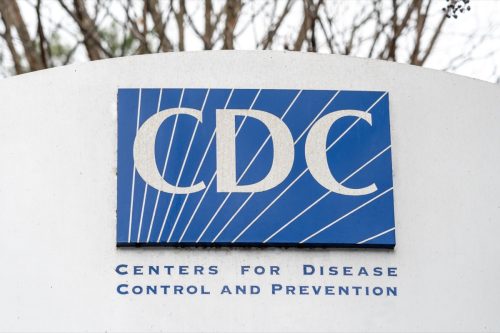Salmonella Outbreak Spreading in 22 States—These Are the Symptoms

No party is complete without a charcuterie board. Who doesn’t love sampling different meats, cheeses, and other sweet and savory snacks? But if you have plans to throw one together for a gathering in the near future, you might want to reconsider. There’s a new Salmonella outbreak that’s been linked to charcuterie meats—and it’s now spreading across 22 U.S. states. Read on to find out what symptoms you need to look out for.
RELATED: CDC Investigating Potential New Symptoms of Spiking JN.1 COVID Variant.
So far, 47 people have gotten sick.

According to a Jan. 18 Food Safety Alert from the Centers for Disease Control and Prevention (CDC), Salmonella illnesses have been reported in 22 states. As of the latest update, 23 new illnesses were reported—bringing the total number up to 47.
The highest number of sick people is in Ohio, where there have been 11 reports of Salmonella, per a map provided by the CDC. Washington reported five sick people, New York reported four, and Wisconsin, Nebraska, Arizona, Texas, and Pennsylvania reported two to three sick people. Utah, Oregon, Colorado, Idaho, Minnesota, Missouri, Illinois, Michigan, Kentucky, Virginia, New Jersey, Mayland, Connecticut, and Vermont reported one sick person each.
The CDC notes that the Salmonella outbreak could extend beyond these states, and that the actual number of sick people is “likely much higher.” According to the agency, some people with Salmonella recover on their own and don’t need medical attention, which leads to an undercount in cases. It also takes between three to four weeks to determine if a sick person is part of a specific outbreak, meaning recent illnesses might not be included in the current counts.
According to a Jan. 18 public health alert from the U.S. Department of Agriculture (USDA) Food Safety and Inspection Service (FSIS), onset dates for illnesses range from Nov. 20, 2023, to Jan. 1, 2024.
RELATED: Deadly Salmonella Outbreak Spreading in 34 States—These Are the Symptoms.
Two charcuterie products sold at Costco and Sam’s Club may be contaminated.

The outbreak has been tied back to contaminated food, namely Busseto brand Charcuterie Sampler and Fratelli Beretta brand Antipasto Gran Beretta. The Busseto product was sold at Sam’s Club and sold in a twin-pack (two 9-ounce trays) with prosciutto, sweet soppressata, and dry coppa. The Fratelli Beretta products were sold at Costco in a twin-pack (two 12-ounce trays) with black pepper-coated dry salami, Italian dry salami, dry coppa, and prosciutto.
According to the FSIS, the state of Minnesota identified the outbreak from an unopened package of the Busseto product, prompting a recall on Jan. 3. The original recall only affected one lot code, but now, the CDC notes that any lot code of both the Busseto and the Fratelli Beretta products could be contaminated.
If you bought either of these products from Sam’s Club or Costco, the CDC and the FSIS urge you not to eat them and to throw them away instead. You should also wash surfaces and containers that may have come in contact with either of these products.
Investigators are now looking into whether other products could be contaminated, per the CDC.
Symptoms largely affect the stomach and intestines.

According to the FSIS, foods contaminated with Salmonella bacteria can cause salmonellosis. This illness can cause several unpleasant symptoms, including diarrhea, abdominal cramps, and fever. These can appear between six hours and six days after eating a contaminated product, and the illness typically lasts between four and seven days.
According to the Mayo Clinic, nausea, vomiting, chills, and headache are other possible signs of salmonella infection.
RELATED: FDA Warns Common Soda Ingredient Is Toxic to Your Thyroid.
Seek medical attention if you have severe symptoms.

The FSIS notes that most people do recover without treatment, but some develop severe diarrhea that requires hospitalization. Older adults, infants, and immunocompromised people are more likely to develop severe illnesses that could require medical attention or hospitalization.
If you start to feel sick and experience severe Salmonella symptoms, call your healthcare provider immediately, the CDC says.
Severe symptoms include diarrhea and a fever higher than 102 degrees Fahrenheit; diarrhea for more than three days that isn’t improving; bloody diarrhea; so much vomiting you can’t keep liquids down; and signs of dehydration like not peeing much, feeling dizzy when standing, and experiencing a dry mouth and throat.
RELATED: For more up-to-date information, sign up for our daily newsletter.
Best Life offers the most up-to-date information from top experts, new research, and health agencies, but our content is not meant to be a substitute for professional guidance. When it comes to the medication you’re taking or any other health questions you have, always consult your healthcare provider directly.
- Source: CDC: Salmonella Outbreak Linked to Charcuterie Meats
- Source: USDA: FSIS Issues Public Health Alert for Ready-To-Eat Charcuterie Products Due to Possible Salmonella Contamination
- Source: USDA FSIS: Fratelli Beretta USA, Inc. Recalls Busseto Foods Brand Ready-to-Eat Charcuterie Meat Products Due to Possible Salmonella Contamination
- Source: Mayo Clinic: Salmonella infection